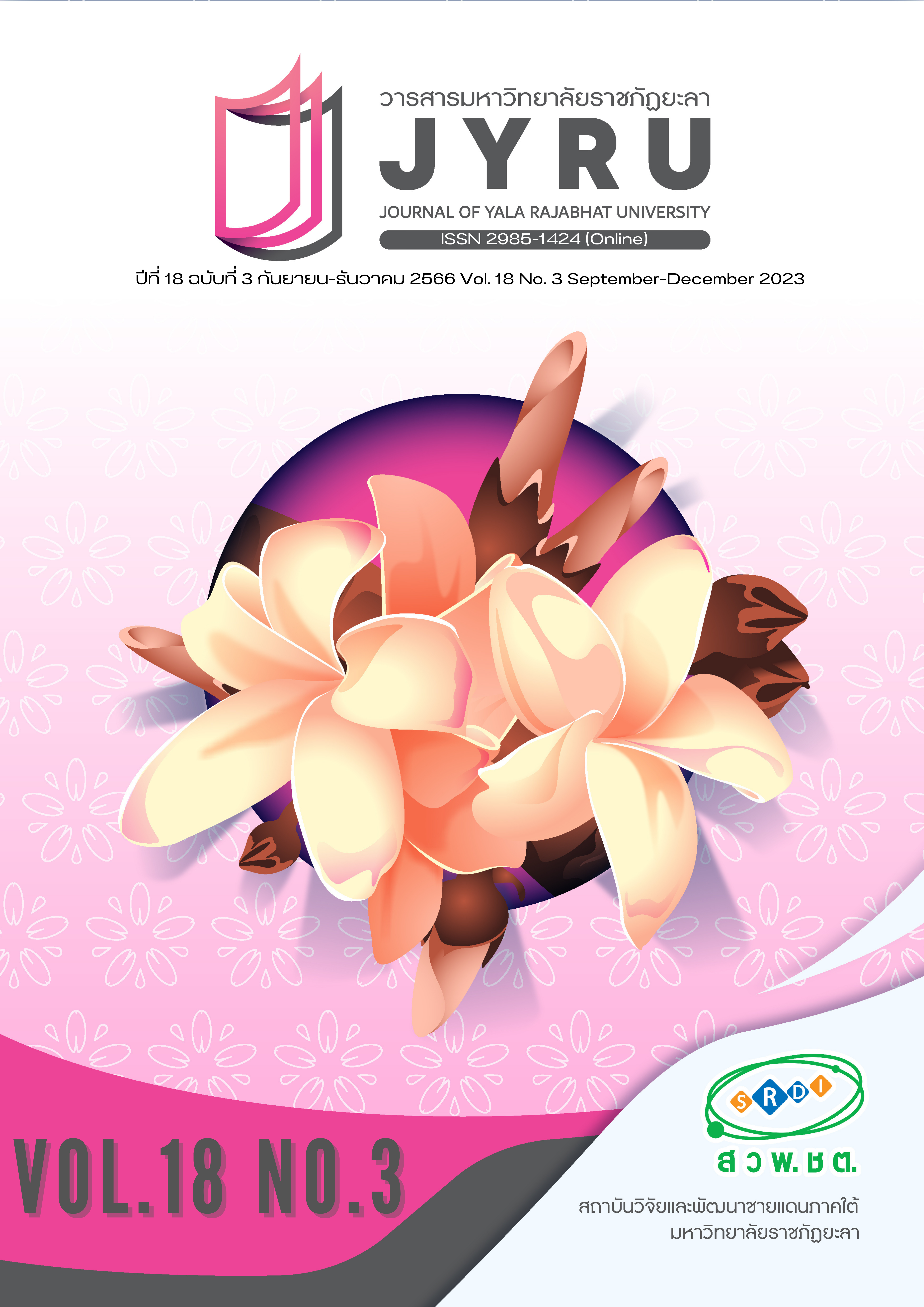การศึกษาผลการจัดการเรียนรู้โดยใช้บริบทเป็นฐานที่มีต่อความสามารถในการแก้ปัญหาทางคณิตศาสตร์ เรื่อง การเรียงสับเปลี่ยนเชิงเส้นและการจัดหมู่ ของนักเรียนชั้นมัธยมศึกษาปีที่ 5 ในสถานการณ์การแพร่ระบาดของโรคติดเชื้อไวรัสโคโรน่า 2019
Main Article Content
บทคัดย่อ
วิธีการเรียงสับเปลี่ยนเชิงเส้นและการจัดหมู่ เป็นวิธีหนึ่งที่ช่วยในการแก้ปัญหาเรื่องความน่าจะเป็น แต่พบว่า นักเรียนส่วนใหญ่ยังไม่เข้าใจหลักการของวิธีดังกล่าว อีกทั้งการจัดการเรียนรู้ในสถานการณ์การแพร่ระบาดของโรคติดเชื้อไวรัสโคโรน่า 2019 ยิ่งทำให้เกิดความลำบากในการเรียนรู้ การวิจัยนี้จึงมีวัตถุประสงค์เพื่อศึกษาความสามารถในการแก้ปัญหาทางคณิตศาสตร์ เรื่อง การเรียงสับเปลี่ยนเชิงเส้นและการจัดหมู่ หลังเรียนด้วยการจัดการเรียนรู้โดยใช้บริบทเป็นฐาน และศึกษาแนวทางการจัดการเรียนรู้โดยใช้บริบทเป็นฐาน ในสถานการณ์การแพร่ระบาดของโรคติดเชื้อไวรัสโคโรน่า 2019 กลุ่มเป้าหมายคือนักเรียนชั้นมัธยมศึกษาปีที่ 5/2 ภาคเรียนที่ 2 ปีการศึกษา 2564 โรงเรียนแห่งหนึ่งในกรุงเทพมหานคร จำนวน 12 คน เครื่องมือที่ใช้ในการวิจัย คือ แผนการจัดการเรียนรู้โดยใช้บริบทเป็นฐาน จำนวน 8 แผน ใบกิจกรรม และแบบทดสอบวัดความสามารถในการแก้ปัญหาทางคณิตศาสตร์ โดยสถิติในการวิเคราะห์ข้อมูลคือ ค่าเฉลี่ย ร้อยละ ส่วนเบี่ยงเบนมาตรฐาน และการวิเคราะห์เชิงเนื้อหา ผลการวิจัยพบว่านักเรียนร้อยละ 75 มีความสามารถในการแก้ปัญหาทางคณิตศาสตร์ในระดับดี และแนวทางการจัดการเรียนรู้โดยใช้บริบทเป็นฐาน ในสถานการณ์การแพร่ระบาดของโรคติดเชื้อไวรัสโคโรน่า 2019 ได้แก่ เลือกใช้บริบทที่เกี่ยวข้องกับชีวิตของนักเรียน ลงมือปฏิบัติกิจกรรมเป็นกลุ่มย่อยที่เน้นกระบวนการแก้ปัญหาผ่านการเรียนรูปแบบออนไลน์ อภิปรายแนวคิดสำคัญที่ได้เรียนรู้ และนำความรู้ไปใช้ในสถานการณ์ใหม่จากบริบทที่คุ้นเคยด้วยตัวเอง จากผลการวิจัยนี้สามารถใช้เป็นแนวทางและพัฒนาการจัดการเรียนรู้เพื่อพัฒนาความสามารถในการแก้ปัญหาทางคณิตศาสตร์ เรื่อง การเรียงสับเปลี่ยนเชิงเส้นและการจัดหมู่ ให้สูงขึ้นได้
Article Details

อนุญาตภายใต้เงื่อนไข Creative Commons Attribution-NonCommercial-NoDerivatives 4.0 International License.
บทความ ข้อมูล เนื้อหา รูปภาพ ฯลฯ ที่ได้รับการเผยแพร่ในวารสารมหาวิทยาลัยราชภัฏยะลานี้ ถือเป็นลิขสิทธิ์ของวารสารมหาวิทยาลัยราชภัฏยะลา หากบุคคลหรือหน่วยงานใดต้องการนำทั้งหมดหรือส่วนหนึ่งส่วนใดไปเผยแพร่ต่อหรือกระทำการใดๆ จะต้องได้รับอนุญาตเป็นลายลักษณ์อักษรจากวารสารมหาวิทยาลัยราชภัฏยะลาก่อนเท่านั้น
เอกสารอ้างอิง
Boonmaton, R., Supap, W. & Wiriyapong, R. (2018). The development of grade 11 students’ mathematical literacy on probability using context-based learning. Academic Services Journal, Prince of Songkla University, 29(2), 51-61. (in Thai).
Ekkapan, P. (2020). The development of mathematical literacy for matthayomsuksa 5 students in graph theory section using context-based learning. Master’s Thesis. Mahasarakham University. (in Thai).
Gudhom, P., Jomhongpipat, P. & Boonchai, P. (2019). The development of enrichment curriculum using metacognition and context base learning to enhance mathematical skills and processes of grade 11 students. Journal of Graduate School Pitchayatat, 14(1), 91 – 98. (in Thai).
John K. G. (2006). On the nature of ‘context’ in chemical education. International Journal of Science Education, 28(9), 957–976.
Kadir, M. A., La, M. & La, M. (2015). Coastal context in learning mathematics to enhance mathematical problem-solving skills of secondary school students. Recent Advances in Education and Educational Technology, 96–102.
Katasila, S. (2020). Open up the perspective of "advantages-disadvantages" study online to keep up with education in the NEW NORMAL. [Online]. Retrieved April 25, 2023, from: https://www2.rsu.ac.th/sarnrangsit-online-detail/Article-online%20learning. (in Thai)
Kaewsaensai, K. & Kijkuakul, S. (2021). Development of context – based learning guideline in the topic probability of grade 10 students. Journal of Yala Rajabhat University, 16(1), 42-51. (in Thai)
Sooksabai, P. (2015). Grade 11th students’ application abilities in daily life about fluid and attitudes towards physics learning using context-based learning. Master’s Thesis. Kasetsart University. (in Thai)
Suksanchananun, C. (2012). The development of junior high school students’ conception and conceptual transferability of heat by contextual learning. Master’s Thesis. Kasetsart University. (in Thai)
Surya, E., Putri, F. A. & Mukhtar. (2017). Improving mathematical problem-solving ability and self-confidence of high school students through contextual learning model. Journal on Mathematics Education, 8(1), 85-94.
Tangkawsakul, S. & Makanong, A. (2017). Development of mathematical activity package by using context based approach and mathematical modelling to enhance mathematical connection abilities and attitude towards mathematics of ninth grade students. An Online Journal of Education, 12(3), 442–458. (in Thai)
The institute for the promotion of teaching science and technology. (2018). Mathematics course manual high school [Online]. Retrieved April 21, 2022, from: https://www.scimath.org/ebook-mathematics/item/8379-2560-2551-8379. (in Thai)
The national institute of educational testing (public organization). (2020). Summary of the national basic educational test (O-NET) grade 12 year 2020 [Online]. Retrieved April 21, 2022, from: http://www.newonetresult.niets.or.th/AnnouncementWeb/Login.aspx?ReturnUrl=%2fAnnounce mentWeb%2fSchool%2fReportSchoolBySchool.aspx%3fmi%3d&mi=. (in Thai)
Vacharathai, J., Lumduanhom, C. & Piasai, K. (2018). A study of conceptual and procedural knowledge deficiencies in permutations of mathayomsuksa v students. Journal of Industrial Education, 17(2), 60–67. (in Thai)
Wongwanich, S. (2017). Classroom action research (19th Ed.). Bangkok: Chulalongkorn University Printing House. (in Thai)
Yu, K. C., Fan, S. C. & Lin, K. Y. (2014). Enhancing students’ problem-solving skills through context-based learning. International Journal of Science and Mathematics Education, 13(6), 1377-1401.


